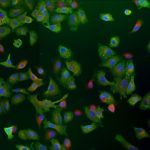Lien vers Pubmed [PMID] – 16940075
Antimicrob Agents Chemother 2006 Nov; 50(11): 3809-15
Geographic spread of highly pathogenic avian H5N1 influenza viruses may give rise to an influenza pandemic. During the first months of a pandemic, control measures would rely mainly on antiviral drugs, such as the neuraminidase (NA) inhibitors oseltamivir and zanamivir. In this study, we compare the sensitivities to oseltamivir of the NAs of several highly pathogenic H5N1 viruses isolated in Asia from 1997 to 2005. The corresponding 50% inhibitory concentrations were determined using a standard in vitro NA inhibition assay. The K(m) for the substrate and the affinity for the inhibitor (K(i)) of NA were determined for a 1997 and a 2005 virus, using an NA inhibition assay on cells transiently expressing the viral enzyme. Our data show that the sensitivities of the NAs of H5N1 viruses isolated in 2004 and 2005 to oseltamivir are about 10-fold higher than those of earlier H5N1 viruses or currently circulating H1N1 viruses. Three-dimensional modeling of the N1 protein predicted that Glu248Gly and Tyr252His changes could account for increased sensitivity. Our data indicate that genetic variation in the absence of any drug-selective pressure may result in significant variations in sensitivity to anti-NA drugs. Although the clinical relevance of a 10-fold increase in the sensitivity of NA to oseltamivir needs to be investigated further, the possibility that sensitivity to anti-NA drugs could increase (or possibly decrease) significantly, even in the absence of treatment, underscores the need for continuous evaluation of the impact of genetic drift on this parameter, especially for influenza viruses with pandemic potential.


